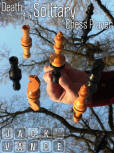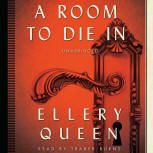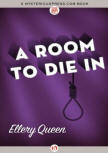


How could a man have been murdered when he was found alone in his study, a gun in his hand, and the door locked from the inside? It had to be suicide, the police figured, for although there was no suicide note there was a letter proving conclusively that Roland Nelson, over the last several months, was being blackmailed. But to his daughter, Ann, whom he had seen only spasmodically since he had left her mother when Ann was a baby, there were unanswered questions. She was convinced that her father could never have killed himself. Before she found the answers, two people were brutally garroted with a wire, one of them in her own apartment. Could she fins all the answers before the killer silenced her, too? |
        |
|
Boucher’s review (September 12, 1965) was mixed. “ 'A Room To Die In' . . . at least resembles hardcover Queen novels in presenting a bona-fide puzzle: a locked room, no less, and a clever one. But the writing is flat and the construction surprisingly amateurish.” Mike Nevins found that certainly the motivation for the murder and some of the killer’s subsequent ploys are not too well thought out, but with its superbly constructed puzzle and the tricky but fair clue that leads to its solution, this novel came much closer than the vast majority of the Queen paperbacks to true-blue EQ. It was ghostwritten by Jack Vance.
Vance specialist Richard Chandler asked
himself if there were any clues in the novels themselves that gave away
their true owner.
He starts off by saying that all three stories Vance wrote for Queen are
set in California with a very strong sense of place. He goes on finding
A Room to Die in another decent mystery with interesting and
unusual characters, some of whom remind me somewhat of ones in Strange
People, Queer Notions. More recently the manuscripts of the three Vance Queens were partially recovered. They were restored and made available. This story was published under its original title Death of a Solitary Chess Player as a supplemental volume to the Vance Integral Edition in 2006. Evidently one of 400 copies printed. Sources report only 100 copies of this volume were printed which explains why it's a really rare find offered at prices ranging from $45 to $122,5 |
 |
| Above: Vance was forbidden by his contract to sign copies of books written under the Ellery Queen pseudonym. As Vance developed a following in his own right (he was an elaborate sci-fi-writer), he did eventually sign the Queen-books as "Jack Vance" or "Ellery Queen" (and initialed "JV").* |
|
|
|
*
Interested readers should know
that the icons/covers
of books, used throughout the
website have extra
descriptions/information not
included in the text on the same
page. Pointing your cursor at
the icon/cover used to reveal
this extra information. To achieve the same effect Firefox users can install an add-on called 'Popup ALT Attribute'. When installed pointing your cursor at an icon/cover results in showing you the details or additional information. |
|
Copyright © MCMXCIX-MMXXIV Ellery Queen, a website on deduction. All rights reserved. |